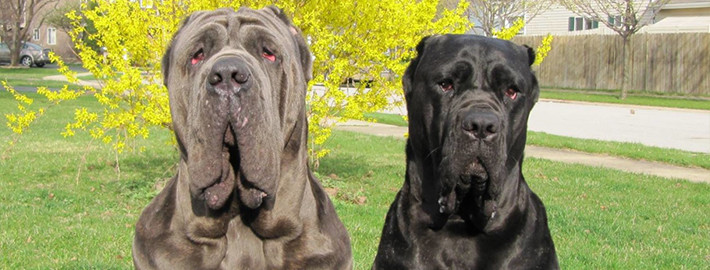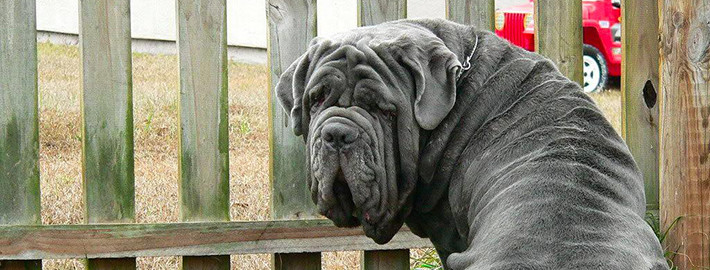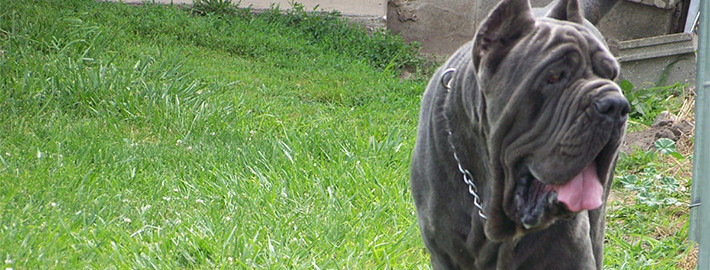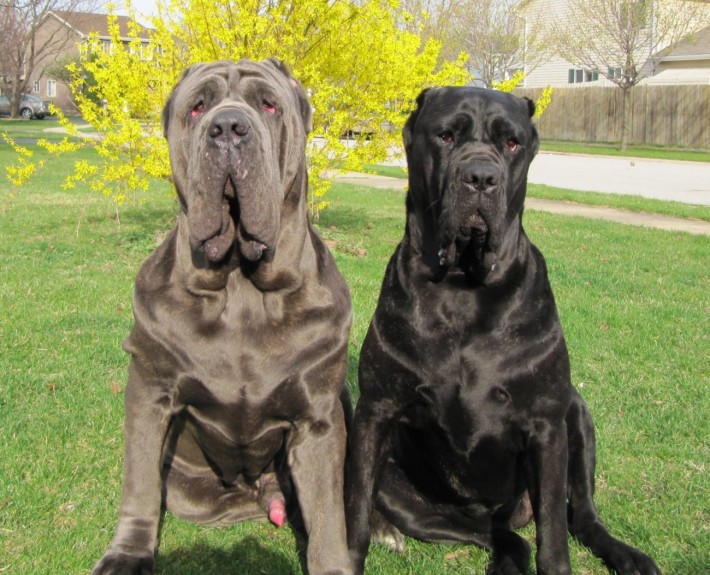What makes the Neapolitan Mastiff Unique?
Neapolitan Mastiffs have served for centuries as a family protector and estate guardian, a role which they continue to fulfil to this very day.
Breed Groups
- Working Dog Breed
- Large Size
Page Contents
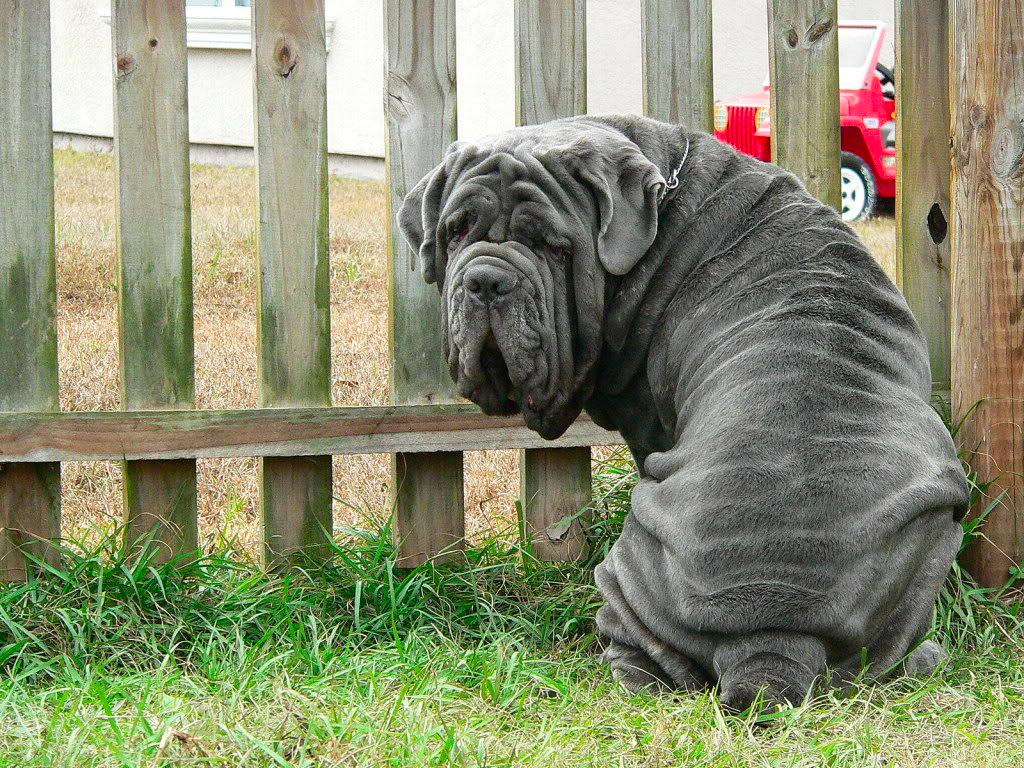
Is the Neapolitan Mastiff Right For You?
Neapolitan Mastiffs tend to be naturally suspicious of strangers but they will tolerate individuals to whom they have been properly introduced. Neapolitan will generally get along just fine with other pets. However, the males may occasionally show aggression towards other dogs of the same gender.
Members of this breed are well-known for their loyalty and devotion to members of their own households. Even so, Neapolitan Mastiffs are not a good choice for amateur dog owners or households that contain youngsters. Although properly socialized members of this breed will get along just fine with children, the dogs’ sheer size increases the likelihood for accidental injuries to occur, especially if the aforementioned playtimes are not closely supervised by responsible adults.
In 5 Words
- Protective
- Stubborn
- Dominant
- Obedient
- Trainable
Characteristics
Learn About the Neapolitan Mastiff
Description
General Description
Members of this massive breed have rectangular bodies that are covered with thick, floppy skin. They also possess wide heads, good-sized teeth, and strong jaws. Scissors, pincher, or somewhat undershot bites are all considered acceptable for members of this breed. Wide muzzles that come to an obvious stop are another breed feature. Neapolitan Mastiffs have large noses should be of a hue that complements their coat color. The same is true of the eyes on members of this breed which can range in color from brown to amber depending on the dog. However, the puppies are born with blue eyes. In places where the practice is not illegal, members of this breed may have their tails and ears cropped short. If their tails are left in their natural state, these appendages will be carried at a level angle and will curl slightly over their owners’ backs. American Kennel Club (AKC) standards state that the front dewclaws should not be removed on members of this breed. Neapolitan Mastiffs also have large, round feet with arched toes on them.
Size
Neapolitan Mastiffs are large animals that stand between 24 and 31 inches (61 and 79 centimeters) in height with the females typically being about 2 inches (5 centimeters) shorter than the males. Male dogs typically weigh anywhere from 130 to 150 pounds (60 to 70 kilograms). Their female contemporaries are generally somewhat smaller at 110 to 130 pounds (50 to 60 kilograms) on average.
Coat
Members of this breed have short, thick coats. Neapolitan Mastiffs come in a wide range of colors including black, blue, grey, and tawny. Chocolate colored animals may also be seen but these individuals are comparatively rare. Brindle and white markings may also be seen on members of this breed but the animal in question should not have any white spots on its face.
Short History of the Neapolitan
Neapolitan Mastiffs are one of the many dog varieties that are thought to be descended from the ancient Molosser breed. It is also presumed that Neapolitan Mastiffs were bred to look imposing so that intruders would be frightened away from the estates these dogs were guarding. While there is no doubt that the creators of this breed succeeded in that objective, Neapolitan Mastiffs are nonetheless quite capable of protecting their domains by force if necessary. Some members of this breed were even used as pit fighters against various wild animals when the practice was legal. Neapolitan Mastiffs became very popular in Europe, but they nearly went extinct during the period following the Second World War. However, the variety was brought back to life due to the actions of a painter named Piero Scanziani, who not only bred the dogs but also campaigned for them to be granted official recognition. Neapolitan Mastiffs were eventually recognized by the American Kennel Club (AKC) in 2004.
Temperament
As was mentioned earlier, these dogs were created to protect humans and guard estates. Therefore, it is not surprising that Neapolitan Mastiffs generally prefer to stay at home rather than venturing out with their human owners. Members of this breed also tend to be naturally suspicious of strangers but they will tolerate individuals to whom they have been properly introduced. Neapolitan will generally get along just fine with other pets. However, the males may occasionally show aggression towards other dogs of the same gender.
Members of this breed are well-known for their loyalty and devotion to members of their own households. Even so, Neapolitan Mastiffs are not a good choice for amateur dog owners or households that contain youngsters. Although properly socialized members of this breed will get along just fine with children, the dogs’ sheer size increases the likelihood for accidental injuries to occur, especially if the aforementioned playtimes are not closely supervised by responsible adults.
Caring for Your Neapolitan Mastiffs
General Health
Litters of Neapolitan Mastiffs typically yield about 6 to 12 puppies but one member of this breed did set a record for giving birth to 24 puppies at once, even if 4 of them did not live for very long. In general, Neapolitan Mastiffs have an average life expectancy of about 7 to 9 years, which is fairly average for a large dog breed. Healthy diets and regular exercise will naturally help these dogs live their lives to the fullest. Even so, health issues that can arise from time to time including cherry eye, hip dysplasia, ectropion, entropion, elbow dysplasia, sebaceous adenitis, hypothyroidism, cardiomyopathy, skin infections and bloat. Regular vet visits are obviously a good way to spot and treat any ailments before they become serious problems. Pet owners should also be aware that Neapolitan Mastiffs tend to be sensitive to anesthesia and will certainly want to keep that in mind when planning surgical procedures for their pets.
Care
Daily
Neapolitan Mastiffs require a great deal of daily exercise in order to be at their best. Twice daily walks are recommended for members of this breed. Proper leash training is likewise essential for good behavior in these dogs.
Weekly
Dogs should have their teeth cleaned on a regular basis to keep them in good oral health. This can be accomplished using a pet approved toothbrush and toothpaste. Tooth powders or specially formulated bones may also help in this regard. The dogs will also benefit from having their coats brushed about once a week because doing so will keep their fur from getting everywhere.
Monthly
All dogs need to be given parasite prevention medications once a month to keep harmful pests at bay and Neapolitan Mastiffs are no different than their contemporaries in this regard.
Grooming & Bathing
These low-maintenance dogs only need to be bathed when they get dirty. However, Neapolitan Mastiff do drool a lot so it may be necessary to clean up their living space on a regular basis. It’s also a good idea to keep their toenails trimmed and their ears cleaned out to keep them healthy.
Exercise & Training
Members of this breed will need to be exposed to plenty of different people while they are young to prevent them from becoming unduly suspicious of strangers later in life. It’s also a good idea to begin teaching them obedience skills at a young age. Training these dogs can still be somewhat difficult because Neapolitan Mastiffs tend to be a bit stubborn. However, consistent rules and a firm hand will go far in helping them learn all the usual skills. Owners should nonetheless be aware that while members of this breed are generally teachable dogs, they see no point in performing tricks and will generally refuse to do so.

